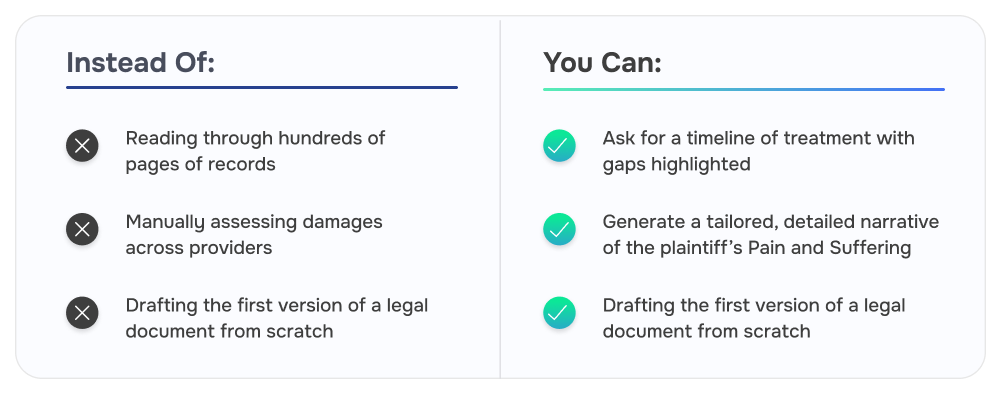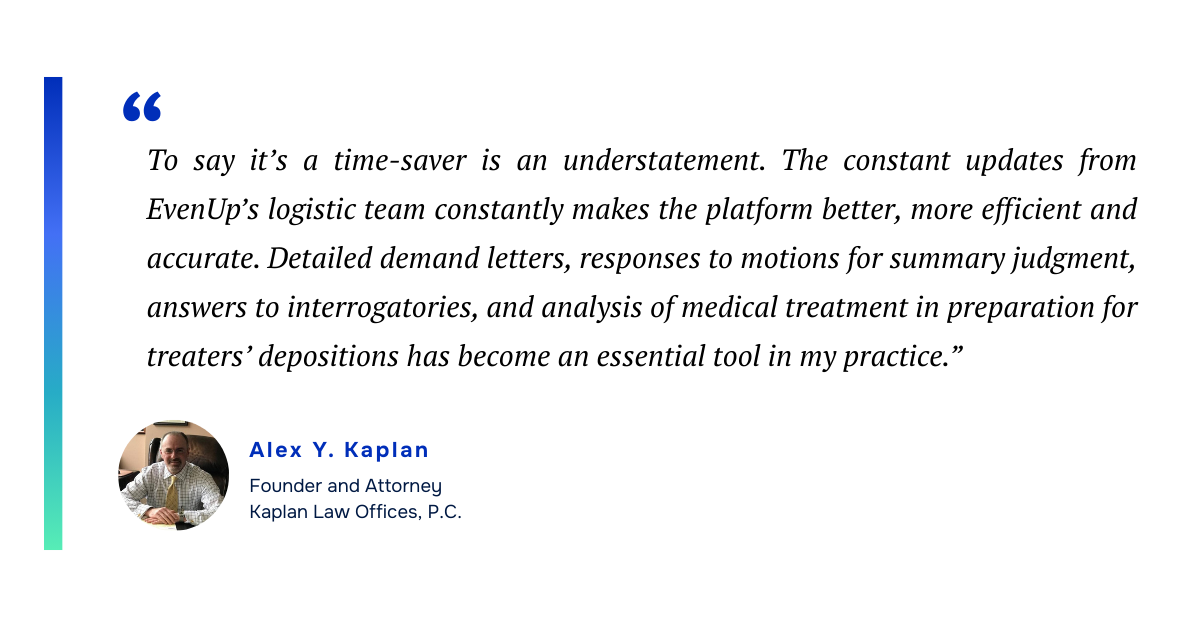Back to Series
A legal AI prompt is a clear and comprehensive instruction, question, or command you give to an AI system to help you complete a task. Whether it’s summarizing a medical record, drafting a complaint, or looking for dates of service, think of it as initiating a conversation with a powerful assistant that can work through case data at speed and scale.
Converse with Your AI to Reach Ideal Outputs
Legal AI prompts can be as simple as a request to generate a legal document. Legal prompts can also be a back-and-forth conversation, where the returned information is iterated or expanded upon in real time to reach the ideal outcome. This iterative exchange may be a few lines at a time. You’ll likely need to write several prompts as the conversation progresses. This is how you move from a rough starting point to a ready-to-use legal document or insight.
While prompting can be open-ended, there are consistent best practices that you can put to use today.

Draft for Hours or Prompt in Seconds?
Your time is better spent on strategy. For attorneys and case managers, prompting with legal AI isn’t about replacing skill—it’s about freeing up time to use them.
Legal work is full of high-value thinking, but also repetitive tasks: summarizing medical records, cleaning up notes, reformatting documents, and chasing down client treatment details.
AI prompting helps you offload repetitive work without sacrificing control or quality.

Best Practices for Prompts that Pop
Prompting is much more than just submitting a question to AI; it’s a disciplined way to unlock the full potential of your legal AI. The most successful firms follow clear best practices:
Prompt for outcomes, not just answers: Frame requests to drive actionable insights, draft-ready content, or case strategies—not surface-level responses.
Use legal language to give additional context: Words like “causation,” “treatment gaps,” “comparative fault,” or “value detractors” encourage more useful phrasing and strategy in answers.
Clarify the case lifecycle stage: Include that you’re working on a pre-lit demand, preparing for deposition, or drafting a trial brief. This added context will help increase the quality of the response.
Standardize your approach: Embed proven prompts into workflows so teams get consistent, repeatable outputs across cases.
Balance tools and custom prompts: Rely on purpose-built features for common needs, while layering in custom prompts for case-specific nuances.
By following these practices, firms move beyond one-off prompts and start using AI as a reliable partner across the case lifecycle.
Accuracy You Can Trust, Time Back You Desperately Need
Prompting turns hours into minutes. It doesn’t replace your expertise, but extends it. In a high-volume, high-pressure environment like personal injury law, it makes the difference between just staying afloat and getting ahead.
To say it’s a time-saver is an understatement. Constant updates from EvenUp makes the platform better, more efficient and accurate. Detailed demand letters, responses to motions, answers to interrogatories, and analysis of medical treatment have become an essential tool in my practice.”
Alex Y. Kaplan
Founder and Attorney
Kaplan Law offices, P.C.

Proper prompting provides massive time savings for case managers, attorneys, and paralegals. The right prompt entered into the right AI platform will replace hours of research, review, or writing with a single input. Successful prompts surface insights, build arguments, and prepare materials that once took hours—in just minutes.
The best personal injury firms are using AI to improve their processes and workflows from intake to resolution. That means:
• Asking the right questions to focus on high-value needs
• Getting clear answers fast with structured prompts
• Embedding those prompts into firm-wide workflows so teams don’t start from scratch every time
Ready to learn how leading PI firms are prompting? Then you’re ready for the next post in the series: Part 2.







